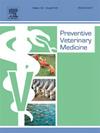从模拟消除野生动物跨境动物疫病的应对措施中汲取业务经验教训。
IF 2.2
2区 农林科学
Q1 VETERINARY SCIENCES
引用次数: 0
摘要
跨界动物疾病(TAD)的引入会对经济、生态和社会产生无数影响。当 TAD 被引入野生物种时,有时需要采取快速、密集的控制措施来减少野生动物宿主的数量,以消除疾病并防止其流行和蔓延到家畜种群。然而,这种高强度的工作并非易事,而且 TAD 的引入非常罕见,这意味着工作人员很少有此类行动的直接经验。因此,对这类工作的操作挑战进行明确评估可以为建立应急响应准备能力提供方向。在此,我们模拟了在野猪(Sus scrofa)中初步检测到假定的 TAD 指数病例(如非洲猪瘟;ASF)时的 TAD 控制工作。我们采用了三种清除方法(空中控制、诱捕和试验性毒饵)。然后,我们进行了事后评估,以确定在模拟疫区内迅速减少入侵野猪数量所面临的操作挑战。我们还模拟了对被驱赶野猪的尸体回收,这与应对以尸体为基础的传播(如 ASF 病毒)的 TAD 时可能采取的措施类似。在此,我们将介绍在我们的工作中发现的操作挑战,以及技术开发解决方案和先验策略需求,以改善 TAD 响应操作结果。本文章由计算机程序翻译,如有差异,请以英文原文为准。
Operational lessons learned from simulating an elimination response to a transboundary animal disease in wild animals
Transboundary animal disease (TAD) introductions can have myriad economic, ecological, and societal impacts. When TADs are introduced into wild species, rapid and intense control efforts to reduce wild animal host populations are sometimes needed to eliminate the disease and prevent endemicity and spillover to domestic animal populations. Yet, such intensive efforts are non-trivial, and the rarity of TAD introductions means that personnel rarely have direct experience with these types of operations. Thus, explicit assessments of operational challenges for these kinds of efforts can provide direction to build emergency response preparedness capacity. Here, we simulated a TAD control effort in response to initial detection of a hypothetical index case of a TAD in wild pigs (Sus scrofa) (e.g., African swine fever; ASF). We used three removal methods (aerial control, trapping, and an experimental toxic bait). Then, we conducted an after-action assessment to identify operational challenges for rapidly reducing a population of invasive wild pigs within a simulated outbreak zone. We also simulated carcass recoveries of dispatched pigs, similar to what might be conducted during a response to a TAD with carcass-based transmission (e.g., ASF virus). Here, we describe operational challenges identified during our effort, alongside technological development solutions and a priori strategy needs to improve TAD response operation outcomes.
求助全文
通过发布文献求助,成功后即可免费获取论文全文。
去求助
来源期刊

Preventive veterinary medicine
农林科学-兽医学
CiteScore
5.60
自引率
7.70%
发文量
184
审稿时长
3 months
期刊介绍:
Preventive Veterinary Medicine is one of the leading international resources for scientific reports on animal health programs and preventive veterinary medicine. The journal follows the guidelines for standardizing and strengthening the reporting of biomedical research which are available from the CONSORT, MOOSE, PRISMA, REFLECT, STARD, and STROBE statements. The journal focuses on:
Epidemiology of health events relevant to domestic and wild animals;
Economic impacts of epidemic and endemic animal and zoonotic diseases;
Latest methods and approaches in veterinary epidemiology;
Disease and infection control or eradication measures;
The "One Health" concept and the relationships between veterinary medicine, human health, animal-production systems, and the environment;
Development of new techniques in surveillance systems and diagnosis;
Evaluation and control of diseases in animal populations.
 求助内容:
求助内容: 应助结果提醒方式:
应助结果提醒方式:


